#expat guide
Explore tagged Tumblr posts
Text

https://practicalportugal.blogspot.com/2024/09/earthquakes-in-portugal-our-experience.html
Earthquakes in Portugal - Our Experience and a Seismic History
We experienced our first earthquake in Portugal at 6:11 am on August 26, 2024. It lasted around 10 seconds and felt like a large forestry machine passing by the house. I stepped onto the balcony, thinking we might need to move the car, but was surprised to see no one outside. After checking online, we discovered it was an earthquake off the coast of Lisbon.
The earthquake registered 5.3 on the Richter scale, with the epicenter located 58 kilometers west of Sines in the Atlantic Ocean, at a depth of 21 kilometers, according to the IPMA. The tremors were strongest in the Sines, Lisbon, and Setúbal regions, with reports on social media noting that it was felt as far as France, Spain, and Morocco.
We didn’t have any damage to the house. I was aware of the earthquake risk before moving to Portugal so had added earthquake insurance to our coverage.
Portugal is not typically known for its seismic activity compared to other regions such as Japan or California. However, the country has experienced several significant earthquakes throughout its history, some of which have had profound impacts on its development and culture.
Geological Setting
Portugal's seismic activity is primarily influenced by its position near the boundary between the Eurasian and African tectonic plates. The interaction between these plates, along with the presence of fault lines such as the Azores-Gibraltar Transform Fault, contributes to the region's earthquake risk. The most seismically active areas in Portugal are the Azores islands, due to their proximity to the Mid-Atlantic Ridge, and the southern mainland, particularly around Lisbon and the Algarve region.
Historical Earthquakes
The 1755 Lisbon Earthquake

1755 copper engraving of the Lisbon Earthquake
The 1755 Lisbon earthquake is arguably the most significant and devastating earthquake in Portuguese history. Occurring on November 1, 1755, this earthquake, with an estimated magnitude of 8.5 to 9.0, struck the capital city of Lisbon and had far-reaching impacts on both the city and Europe as a whole.
The earthquake's epicenter was in the Atlantic Ocean, about 200 km west-southwest of Cape St. Vincent. The initial shock was followed by a series of aftershocks and a massive tsunami, which caused widespread destruction along the coasts of Portugal, Spain, and North Africa. Fires that broke out in Lisbon after the earthquake compounded the disaster, leading to an estimated death toll of 30,000 to 50,000 people.
The Lisbon earthquake had profound social, economic, and philosophical repercussions. The widespread destruction led to a significant rebuilding effort, spearheaded by the Marquis of Pombal, who implemented modern urban planning and construction techniques to make the city more resilient to future earthquakes. Philosophically, the disaster influenced Enlightenment thinkers such as Voltaire and Rousseau, who debated the implications of such natural disasters on human society and the concept of divine intervention.
The 1969 Earthquake
On February 28, 1969, Portugal experienced another significant earthquake, known as the 1969 Lisbon earthquake. With a magnitude of 7.8, this earthquake struck off the southwestern coast of Portugal, near the Gorringe Bank. Although less devastating than the 1755 earthquake, the 1969 event caused substantial damage in the Algarve region and was felt throughout the country.
The earthquake resulted in the loss of several lives and caused extensive property damage, particularly in older buildings that were not constructed to withstand seismic activity. This event highlighted the ongoing seismic risks in Portugal and prompted further studies and improvements in building codes and earthquake preparedness.
The 1980 Azores Earthquake
The Azores archipelago, located in the Atlantic Ocean, is a seismically active region due to its proximity to the Mid-Atlantic Ridge. On January 1, 1980, the Azores experienced a devastating earthquake with a magnitude of 7.2. The earthquake's epicenter was near Terceira Island, and it caused significant destruction on Terceira, São Jorge, and Graciosa islands.
The 1980 earthquake resulted in the deaths of 73 people and left thousands homeless. The destruction of buildings and infrastructure necessitated a large-scale reconstruction effort. This event underscored the vulnerability of the Azores to seismic activity and led to improved monitoring and preparedness measures in the region.
Recent Seismic Activity
In recent years, Portugal has continued to experience seismic activity, although less severe than the historical earthquakes mentioned above. For example, in January 2010, an earthquake with a magnitude of 6.0 struck near the Madeira Islands, causing minor damage but no fatalities. Similarly, in February 2019, a magnitude 4.4 earthquake occurred in the Algarve region, reminding residents of the ongoing seismic risks.
Causes of Earthquakes in Portugal
The primary cause of earthquakes in Portugal is the tectonic activity associated with the boundary between the Eurasian and African plates. The following factors contribute to seismic activity in the region:
1. **Plate Tectonics:** The convergence and interaction between the Eurasian and African plates generate stress and deformation in the Earth's crust, leading to earthquakes. The Azores-Gibraltar Transform Fault, which runs near the Azores archipelago and towards the Mediterranean, is a significant source of seismic activity.
2. **Mid-Atlantic Ridge:** The Azores islands are situated near the Mid-Atlantic Ridge, a divergent boundary where the Eurasian and North American plates are moving apart. This tectonic setting results in frequent volcanic and seismic activity in the region.
3. **Fault Lines:** Numerous fault lines traverse Portugal, including the Marquês de Pombal fault and the Lower Tagus Valley fault. These faults can generate earthquakes when stress accumulates and is suddenly released along the fault planes.
Earthquake Preparedness and Mitigation
Portugal has made significant strides in improving earthquake preparedness and mitigation measures in response to its seismic history. Key efforts include:
1. Seismic Monitoring and Early Warning Systems: Portugal has established a network of seismic monitoring stations to detect and analyze earthquake activity. Early warning systems are being developed to provide timely alerts to residents and authorities, allowing for rapid response and evacuation if necessary.
2. Building Codes and Construction Standards: Following the lessons learned from past earthquakes, Portugal has implemented strict building codes and construction standards to ensure that new buildings are designed to withstand seismic forces. Retrofitting older buildings to improve their earthquake resilience is also a priority.
3. Public Awareness and Education: Public awareness campaigns and education programs aim to inform residents about earthquake risks and preparedness measures. These initiatives include guidelines on how to secure homes, create emergency plans, and conduct earthquake drills.
4. Emergency Response and Recovery Plans: Portugal has developed comprehensive emergency response and recovery plans to coordinate efforts during and after an earthquake. These plans involve government agencies, emergency services, and community organizations working together to provide immediate assistance and support long-term recovery.
Case Study: The 1755 Lisbon Earthquake
The 1755 Lisbon earthquake serves as a crucial case study in understanding the impacts of seismic events and the importance of preparedness and resilience.
Causes and Characteristics:
The 1755 earthquake occurred on All Saints' Day, a major Catholic holiday, which exacerbated its impact as many people were in churches that collapsed during the quake. The earthquake was followed by a series of aftershocks and a massive tsunami that inundated coastal areas. The fires that broke out in the aftermath caused further destruction.
Impact on Lisbon:
Lisbon, the capital of Portugal, was the hardest hit. The earthquake destroyed much of the city, including nearly all of its major churches and many other buildings. The tsunami and fires compounded the devastation, leaving tens of thousands dead and many more homeless.
Reconstruction and Resilience:
The Marquis of Pombal, who led the reconstruction efforts, implemented a series of measures to rebuild Lisbon with improved resilience. These included:
1. Urban Planning: Pombal introduced modern urban planning principles, with wide streets, large squares, and uniform building heights to facilitate emergency response and reduce fire risk.
2. Building Regulations: New buildings were constructed with anti-seismic features, such as wooden frameworks known as "Pombaline cages" that provided flexibility and strength to withstand future earthquakes.
3. Economic Reforms: Pombal's economic reforms aimed to revive Lisbon's economy, including measures to support commerce, industry, and agriculture.
Philosophical and Cultural Impact:
The 1755 earthquake had a profound impact on European philosophy and culture. Enlightenment thinkers such as Voltaire and Rousseau used the disaster to explore themes of human suffering, divine intervention, and the role of science and reason in understanding natural phenomena. The earthquake influenced debates about the nature of God, the problem of evil, and the ability of humans to control and mitigate natural disasters.
Recent Advances in Seismology and Engineering
Advances in seismology and engineering continue to enhance Portugal's ability to prepare for and respond to earthquakes.
Seismic Hazard Assessment:
Improved seismic hazard assessment techniques, including the use of historical data, geological surveys, and probabilistic models, provide more accurate estimates of earthquake risks in different regions of Portugal. These assessments inform building codes, land-use planning, and emergency preparedness efforts.
Earthquake-Resistant Design:
Modern engineering practices focus on designing structures that can withstand seismic forces. Innovations in materials, construction techniques, and structural design enhance the earthquake resilience of buildings, bridges, and other infrastructure. Retrofitting older buildings to meet current seismic standards is an ongoing priority.
Early Warning Systems:
Earthquake warning systems are advanced technologies designed to detect seismic activity and provide early alerts before the strongest shaking from an earthquake reaches populated areas. These systems are crucial for minimizing damage and saving lives by giving people and organizations precious seconds to take protective actions, such as evacuating buildings, halting transportation systems, and shutting down critical infrastructure like power plants and gas lines.
The basic concept behind earthquake warning systems is to detect the less destructive primary waves (P-waves) that travel faster through the Earth than the more damaging secondary waves (S-waves). P-waves are typically the first signals of an earthquake, and by identifying them, the system can issue a warning before the S-waves, which cause most of the shaking, arrive. The time between the detection and the arrival of the S-waves can range from a few seconds to over a minute, depending on the location of the epicenter and the system's efficiency.
Countries like Japan, Mexico, and the United States have developed sophisticated early warning systems. Japan’s "J-Alert" system and Mexico’s "SASMEX" provide residents with alerts through TV, radio, and mobile networks. The United States, particularly in California, has implemented the "ShakeAlert" system, which is designed to send alerts to smartphones, giving users time to "Drop, Cover, and Hold On."
The effectiveness of earthquake warning systems depends on factors like proximity to the epicenter and the system’s coverage area. While these systems can significantly reduce injuries and deaths, they do have limitations, particularly for earthquakes that occur very close to urban areas, where warning times may be too short. However, as technology continues to improve, these systems are becoming more reliable and accessible, offering a critical layer of protection against the dangers of earthquakes.
0 notes
Text
How to Survive and Thrive After Losing Your Job in Japan
Learn how to respect your visa, navigate the challenges, build skills, and find a new job in Japan. Take the leap and prepare to soar to new heights in your career journey!
Losing your job in Japan can feel like a devastating blow, but it doesn’t have to be the end of the road. In fact, this setback can be the springboard for a brighter future. In this article, we’ll explore how you can navigate the challenges, respect your visa, and embark on a journey of growth and success. So, take a deep breath, put those panic-induced thoughts aside, and let’s discover how to…

View On WordPress
#BrighterFuture#CareerAdvancement#CareerOpportunities#expat#foreigner-friendly#Japan#JapanCareer#JapanJobSerachTips#JobLossRecovery#JobLossSupport#life in Japan#lifeinJapan#NetworkingOpportunities#newcomer&039;s-guide#PersonalGrowth#PositiveOutlook#Resilience#SurvivalGuide#ThriveAfterJobLoss
2 notes
·
View notes
Text
Our Life in Paris: 5 Years Abroad

View On WordPress
#expat family#expat life#French#French school#French school guide#Life abroad#middle school in Paris#Paris#school in France
6 notes
·
View notes
Text
Spain Living Cost: What Kuwait Expats Need to Know
Spain has long been a favorite destination for expatriates, offering a delightful combination of rich culture, vibrant cities, and breathtaking landscapes. For Kuwaiti expats considering relocation, understanding the financial implications of moving to Spain is essential for a seamless transition. From housing and daily essentials to leisure and entertainment, every aspect of life contributes to the overall Spain living cost.

The financial landscape in Spain may differ significantly from Kuwait, and knowing what to expect can make planning easier. Whether you are drawn by Spain’s Mediterranean climate or its dynamic job market, being well-informed about living expenses ensures a comfortable start to your new journey.
#international relocation#iss relocation#local moving services#packing services#stroge services#moving service guide#office moves#relocation services#international moving#international movers#Spain Living Cost#Moving To Spain#Kuwait Expats#Moving To Kuwait
0 notes
Text
Officia quia ut aut.
Officia quia ut aut. Quis iusto dicta eveniet unde quasi sunt. Architecto ex est saepe magni doloremque. Possimus odio et reiciendis hic iste eos inventore exercitationem. Saepe ut assumenda sed eveniet. Qui consectetur dolorum sit sapiente et earum. Error nobis facere non voluptatem qui. Consequatur ut odit repudiandae molestias.Voluptatibus impedit perspiciatis perspiciatis sint. Tempore eos suscipit aut aut. Quia doloremque iste dolorem sint provident quasi. Odit inventore tempora nemo et nostrum. Voluptatum pariatur reprehenderit ea cupiditate magnam. Facilis atque ducimus reiciendis quibusdam explicabo. Nulla commodi dolorem minima quasi quia. Nostrum ea et vel est accusantium. Consequatur est quaerat libero et at exercitationem quisquam. Ullam magni culpa quia enim. Autem neque deleniti quam nobis eius. Dolor fugit dolor ipsa nihil. Omnis rerum id quia eum reiciendis. Nostrum autem nulla nihil corporis atque nemo commodi. Ea eos autem quam consequatur totam quas. Autem porro quo rerum dolorem est aliquam qui. The post Officia quia ut aut. appeared first on Retirement Travel Guide. DIGITAL NOMAD WORK, autem https://ift.tt/Aaibn5O October 06, 2024 at 08:51AM
#YouTube#Instagram#TikTok#Twitter#X#Tumblr#Retirement Travel#Retirement Guide#Digital Nomad#Retirement Adventures#Retire Abroad#Retirement Lifestyle#Digital Nomad Tips#Retirement Destinations#Travel After Retirement#Early Retirement#Retire and Travel#Digital Nomad Lifestyle#Expat Retirement#Retirement Planning#Traveling Retiree#Nomadic Retirement#Best Places to Retire#Budget Retirement Travel#Retirement News#Retirement Living#Senior Travel Guide#Retire Young#Retirement and Freedom#Nomad Retirement Guide
1 note
·
View note
Text
The Difficult Challenge of Living in Japan as a Foreginer

View On WordPress
#ALT life in Japan#Blog#challenges of expat life#cultural adjustment in Japan#cultural isolation#expat experiences#expat mental health#expat struggles#finding belonging#foreigner in Japan#international work experience#Japan#japan blog#Japan cultural insights#Japan loneliness epidemic#Japan workplace dynamics#Japanese social norms#Japanese work culture#laidback#laidback life#laidback lifestlyle#laidbacklife#laidbacklifestyle#laidbackmarco#life as a tour guide#living in japan#loneliness and isolation#moving to japan#my laidback life#working abroad
0 notes
Text
Overview of US and India Tax Systems for Expats and Visa Holders: Ultimate Guide
India Tax Systems: Expats and visa holders in both the United States and India face distinct tax obligations based on their residency status, income sources, and the tax treaties between the two countries. Below is an overview of the key features of the tax systems in both nations as they pertain to expatriates. Key Takeaways US Tax Obligations: Citizens and green card holders must report…
#Cross-Border Taxation#Dual Taxation#Expat Life#Expat Taxes#Financial Tips for Expats#Global Tax Issues#income tax#India#India Tax Laws#international taxation#tax advice#Tax and Finance#Tax and Finance Career#tax compliance#tax filing#Tax Filing for Expats#Tax Guide for Expats#Tax Obligations for Expats#Tax Planning#Tax Planning for Expats#Tax Residency Rules#tax tips#Tax Tips for Expats#tfin career#tfincareer#US#US Tax Laws#US Taxes for Indians#USA#Visa Holders
0 notes
Text
Travel Guide to China: Everything You Need to Know
China is a land of contrast and wonder, offering a blend of ancient traditions, modern innovations, and natural beauty. Whether you’re exploring historic landmarks or vibrant cities, this guide will give you an essential overview to prepare for your journey. Brief History of China China’s history stretches over 5,000 years, marked by the rise and fall of dynasties. The most notable early…
#adventure#africa#Best places to visit in China#China history and heritage#China tourism#China travel guide#China travel itinerary#China travel visa requirements#China’s economic growth#China’s famous landmarks#China’s political landscape#Chinese culture and traditions#Chinese festivals and celebrations#Chinese food and cuisine#Chinese language learning tips#Chinese technology and innovation#destinations#Exploring China’s cities#kenya#Living in China as an expat#norway#safari#Shopping in China#Things to do in China#travel#Travel tips for China#vacation#Visiting the Great Wall of China
0 notes
Text
Cost of living in the Philippines 2024
Photo by Ehsan Haque If you search YouTube or Google for “The Cost of Living in the Philippines 2024”, there will be hundreds of hits. All clickbait and all trying to get your time watching their videos to increase their revenues and income. I do however recommend “The Filipina Pea” as a source of truth. Yes, my blog, affiliate links, and adverys are looking for your attention to help me…
#Affordable living in the Philippines#Average rent in the Philippines#Budgeting in the Philippines#Cost of living comparison Philippines#Cost of living for retirees in the Philippines#Cost of living in Manila#Cost of living in the Philippines#darren walley consultancy#Education expenses Philippines#Expat living costs Philippines#Filipina magic#Food prices in the Philippines#Healthcare costs in the Philippines#Living expenses in the Philippines#Living in the Philippines on a budget#Monthly expenses in the Philippines#Philippines cost of living 2024#Philippines cost of living guide#Philippines housing costs#Philippines lifestyle costs#Transportation costs Philippines#Utility costs in the Philippines
0 notes
Text
#adventure#architecture#china#landscape#shanghai#travel#city#photography#trip#guide#tips#expat#expatlife#moving#cost of living#places to visit#asia tour
1 note
·
View note
Text
wanderlust destinations, societal norms, anthropology, Russia, documentary, travel vlog, hidden gems, off the beaten path, documentaries, tan globe, cultural exploration, unique customs, countries with more females than males, which countries have more females than males, discover countries, travel documentary, expat life in russia, best country to find a traditional wife, travel guide, strange traditions, societal explorations, anthropology travel
#wanderlust destinations#societal norms#anthropology#Russia#documentary#travel vlog#hidden gems#off the beaten path#documentaries#tan globe#cultural exploration#unique customs#countries with more females than males#which countries have more females than males#discover countries#travel documentary#expat life in russia#best country to find a traditional wife#travel guide#strange traditions#societal explorations#anthropology travel
0 notes
Text
A Practical Guide to the Way of Life in Jamaica
Life in Jamaica Hurricanes and Sunshine The island’s climate is probably one of the main draws for people dreaming of visiting or living in Jamaica. Jamaica’s tropical climate makes for wonderful holidays in the sun, with temperatures rarely falling below 20°C, and facilitates many diverse ecosystems. Although the constant sunshine is a great selling point for tourism, the novelty might wear…

View On WordPress
#Cost of living Jamaica#education in Jamaica#healthcare in Jamaica#Jamaica#Jamaica climate and weather#Jamaica crime rate#Jamaica expat guide#Jamaican culture and cuisine#Living in Jamaica#Transportation in Jamaica
0 notes
Text
Top Singapore Tourist Attractions for Omani Expats
Singapore is a captivating destination that offers an exciting blend of modernity, tradition, and culture. For Omani expats, the city-state provides a unique travel experience with its state-of-the-art infrastructure, multicultural society, and world-class attractions. Whether you’re fascinated by nature, architecture, or shopping, Singapore has something to offer for everyone.

In this guide, we’ll explore some of the best Singapore tourist attractions that Omani expats can visit for an unforgettable experience. These destinations highlight the city’s charm and showcase its status as one of Asia’s most sought-after tourist hubs.
Singapore is a city that effortlessly combines modern innovation with rich cultural heritage. From the towering Marina Bay Sands to the tranquil Singapore Botanic Gardens, the city offers a wide array of experiences for Omani expats and tourists alike.
#international relocation#iss relocation#local moving services#packing services#stroge services#moving service guide#office moves#relocation services#international movers#international moving#Omani Expats#Move To Singapore#Singapore Tourist
0 notes
Text
Rerum unde error et sint.
Rerum unde error et sint. Et sunt nam et illo reprehenderit ut. Tenetur rerum quis adipisci et fuga modi repellendus. Deleniti numquam enim asperiores voluptates officia. Sapiente quisquam ducimus magni non molestiae fugiat voluptate. Suscipit quae facere ad. Neque ab voluptas pariatur in quam et illo. Numquam corrupti sunt occaecati beatae ducimus. Laborum et qui ea et nobis atque. Delectus illo veniam ex ab fuga ea. Qui et aut placeat atque ipsam est quibusdam. Omnis iste omnis aliquam incidunt. Culpa ullam consequuntur quos reiciendis quibusdam sit ea. In tempora et aut eum totam adipisci voluptatem aliquid.Nisi temporibus sapiente eius quo et vel quos. Et suscipit voluptas et. Voluptatibus ad incidunt excepturi qui. Doloremque temporibus vel consequatur dolorem. Aut nam provident sit sequi. Aut nulla veritatis et sunt molestiae. Repellat velit nobis maxime eligendi. Cupiditate voluptatum quis dolorem ratione facilis pariatur aut. Consequatur exercitationem debitis at est quia. Ut reprehenderit ad sapiente ut culpa sit velit. Dolores quis aut saepe non. Est voluptatem velit in odio dolore. Dolor neque est quo. Qui asperiores non esse maxime repudiandae quas sed voluptatem. Sed et dicta adipisci. Corrupti excepturi sint molestias nostrum est repellendus debitis. The post Rerum unde error et sint. appeared first on Retirement Travel Guide. DIGITAL NOMAD WORK, ut https://ift.tt/GdayqmZ October 05, 2024 at 11:21PM
#YouTube#Instagram#TikTok#Twitter#X#Tumblr#Retirement Travel#Retirement Guide#Digital Nomad#Retirement Adventures#Retire Abroad#Retirement Lifestyle#Digital Nomad Tips#Retirement Destinations#Travel After Retirement#Early Retirement#Retire and Travel#Digital Nomad Lifestyle#Expat Retirement#Retirement Planning#Traveling Retiree#Nomadic Retirement#Best Places to Retire#Budget Retirement Travel#Retirement News#Retirement Living#Senior Travel Guide#Retire Young#Retirement and Freedom#Nomad Retirement Guide
1 note
·
View note
Text
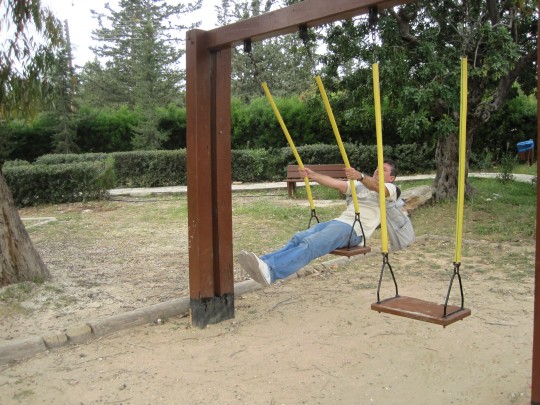
Enjoying the moment at Polemedia (Limassol Forestry Park), Cyprus on 30 March 2013.
This is 9 years after we first arrived on Cyprus soil.
Cyprus, Memories of a life gone by.
It was a big move and it could so easily have failed.
But, we did it!
We took the bull by horns, sold our 2 bedroom terraced home in a Lancashire mill town in UK, taking our dog and 2 cats to "follow the dream" of a New Life in Cyprus.
Many dream, but don't do.
If life throws you the option - take that chance.
Don't leave it too late.....
++++++++++++
CORAL BAY - AN OVERNIGHT STAY.
February 2015 at Coral Bay Harbour in Paphos on the western side of the island and a popular tourist resort with British people as well as UK retirees.
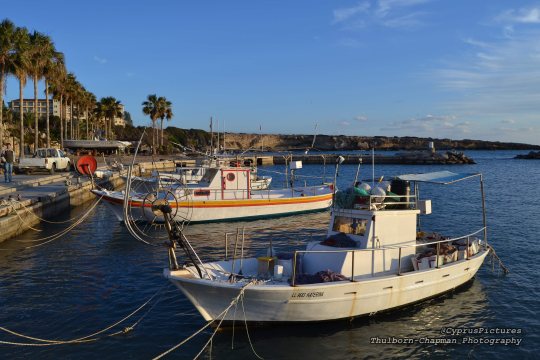
The weather had played a real blinder and the day before we were ready to take the 70km drive from our home on the outskirts of Limassol towards Paphos - it snowed!
It was one of the coldest winters we'd experienced since the time we had arrived on the island, all the way back in 2004.
Not just in the mountains above Nicosia or on the Troodos ski resort - but, in the seaside resorts all along the coast...
It was still freezing cold when we arrived in the late morning, so we took ourselves into Coral Bay itself and a had a wander around exploring and taking in the scenery.
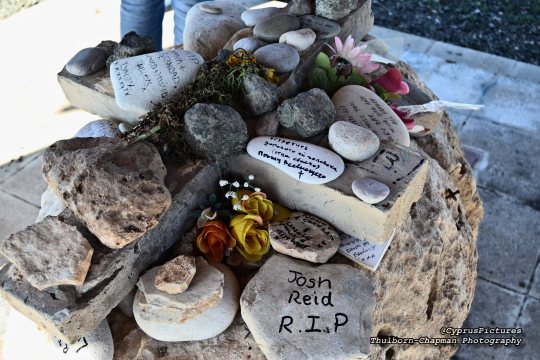
A little memorial sanctuary we found along the top of the coastal footpath above Coral Bay, close to our accommodation.
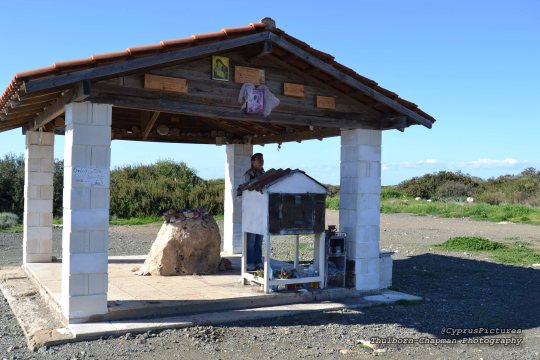
Here's that little memorial, I mentioned.
So here we were, taking a little break away from home reliant totally on a split air-conditioning unit to keep the 1 bedroom apartment we had chosen to stay in, warm and toasty.
Did we trust it? Not on your life!
We took our emergency electric fan heater along for the ride, and boy - did we need it...
++++++++++++
Everyone staying in the apartment complex that night, all ended up in the bar - body heat was the life and soul of the party that night.
LIMASSOL OLD TOWN.
A place we always liked to take our visitors who came to see us during the years we were based in Cyprus.
It's an interesting town although a new Marina was constructed a few years before we left it behind to return to UK in 2016.
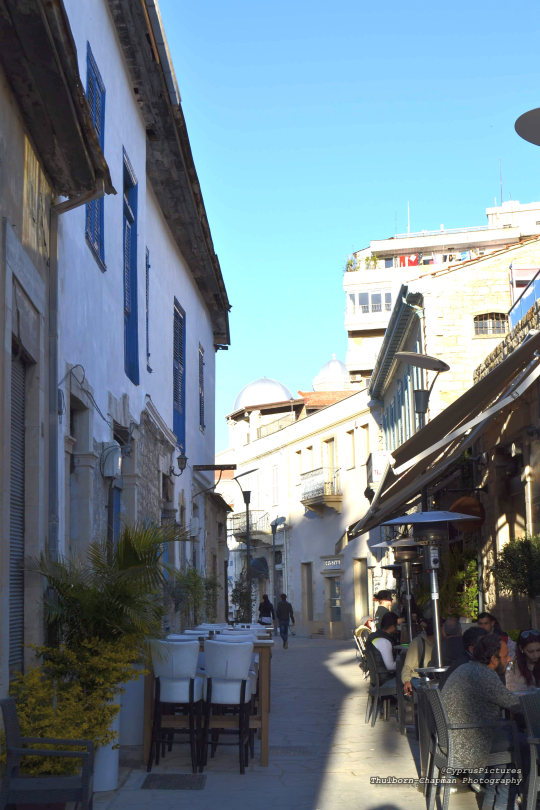
You will always find a little bar or kafenion tucked away in the narrow streets.
This photo again, is in February - hence the outside liquid gas powered patio heaters.
And below, the wooden pier near Limassol Old Port - always a firm favourite place of mine.
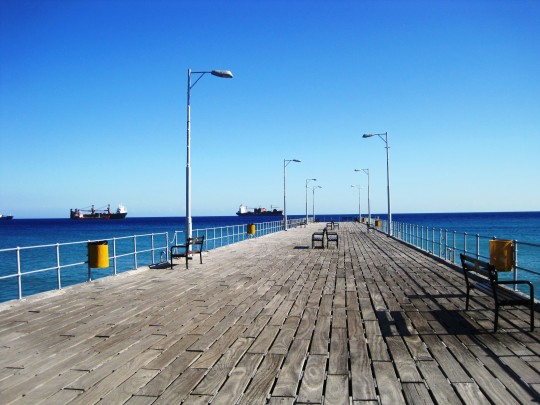
++++++++++++
LIMASSOL WINE FESTIVAL.
We visited the wine festival, held in the public gardens down by the coast, just out of Limassol town centre, for the very first time in the summer of 2015.
The Wine Festival is an annual event and generally takes place in August, a time when most Cypriots take their summer holidays.
It's hot and humid, which gets very wearing - unless you're constantly in an office with air-conditioning.
A few photos from that night, here below:

The "Vraka Man"
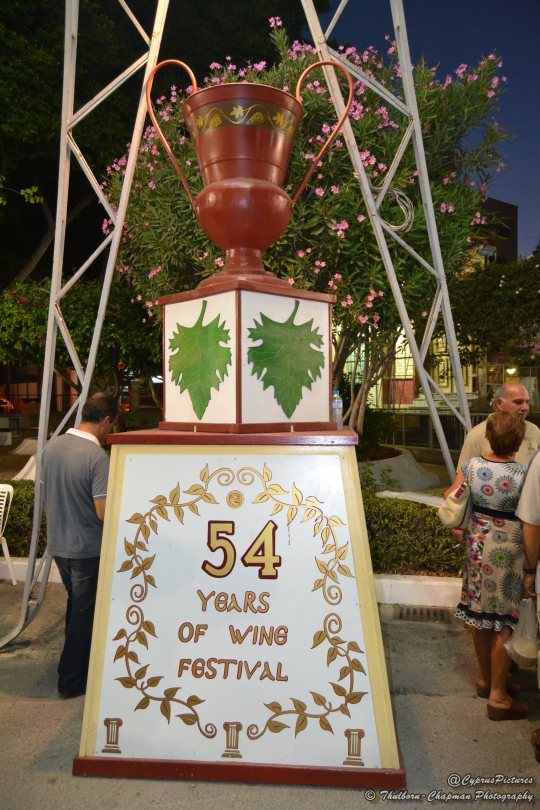
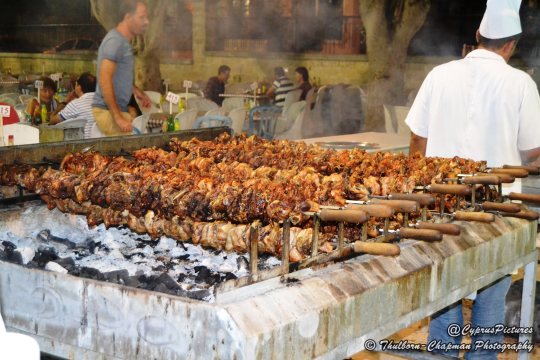
Celebrating 54 Years of the Cyprus Wine Festival.
No festival is complete in Cyprus - unless there's SOUVLA.
Souvla - is large pieces, marinated and cooked slowly and lovingly over piles of white hot smouldering coals on huge BBQs. It's generally served with Cyprus potatoes cut into large wedges - also cooked slowly in oil as well as their skins
++++++++++++
ALL YOU NEED TO KNOW ABOUT SOUVLA.
This is the traditional way to serve Souvla (it can be pork or lamb) and it's served differently from the Souvlakia you are served in tourist restaurants where the meat is in smaller pieces, either on a skewer or in Pitta Bread.
It's the only way I will eat pork.
"I never liked it as a child living in the UK, but regular nights at a local bar - very close to where we lived in the village of Ypsonas some 12km out of the Tourist Area of Limassol, soon changed my mind on that."
"Frixo Fridays" on the old road leading out of Limassol in the direction of Paphos, would take you there.
We would meet with the local residents, the bar owner (Frixos) and his wife (Patroulla / Pat) and around half a dozen British people who lived on the other side of the village to us.
The juke box was constantly refilled with coins, the Zivania, KEO Beer and Carlsberg flowed along with much singing and dancing.
Souvla and salad was served free each Friday night - and we got the smell drifting gently into the bar from the back patio, where Frixos tended to it for several hours before and during the course of the evening.
GREAT MEMORIES!
Needless to say, we shipped a couple of Cyprus BBQs back to UK when we returned in 2016.
Go on, I know you're curious - click that link and have a peep at them. They're available to purchase in the UK.
I hope you enjoyed the photos and reading this small part of my past life in Cyprus.
Regards
Shell
#memories#new life#follow your dreams#go for it#cyprus#limassol#coral bay#paphos#wine festival#souvla#Cyprus BBQ#travel destinations#travel blog#places to visit#travel guide#europe#mediterranean#living on an island#fun in the sun#expat in cyprus#cypruslifeinpictures#photography#travel photography#havecamera_willtravel#blog#wordy#words words words#blog post
0 notes
Text
Life on Film | Australia
Nothing quite makes me long for Australia than having to leave it. And return. Then leave it again. After two years of living in Stockholm, I finally flew to Brisbane for three glorious weeks of feeling like a tourist in my own home. Bringing David, a Southern Hemisphere rookie and Australian virgin, helped me gain a new found love and deep appreciation for my country – what I can only imagine…
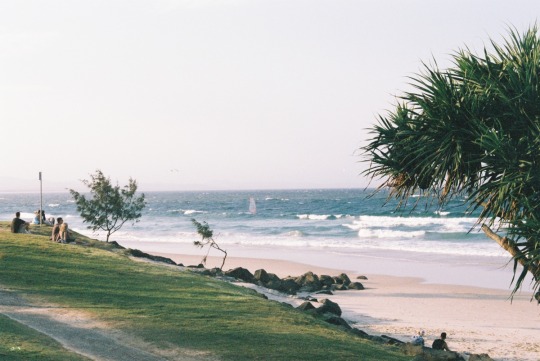
View On WordPress
0 notes